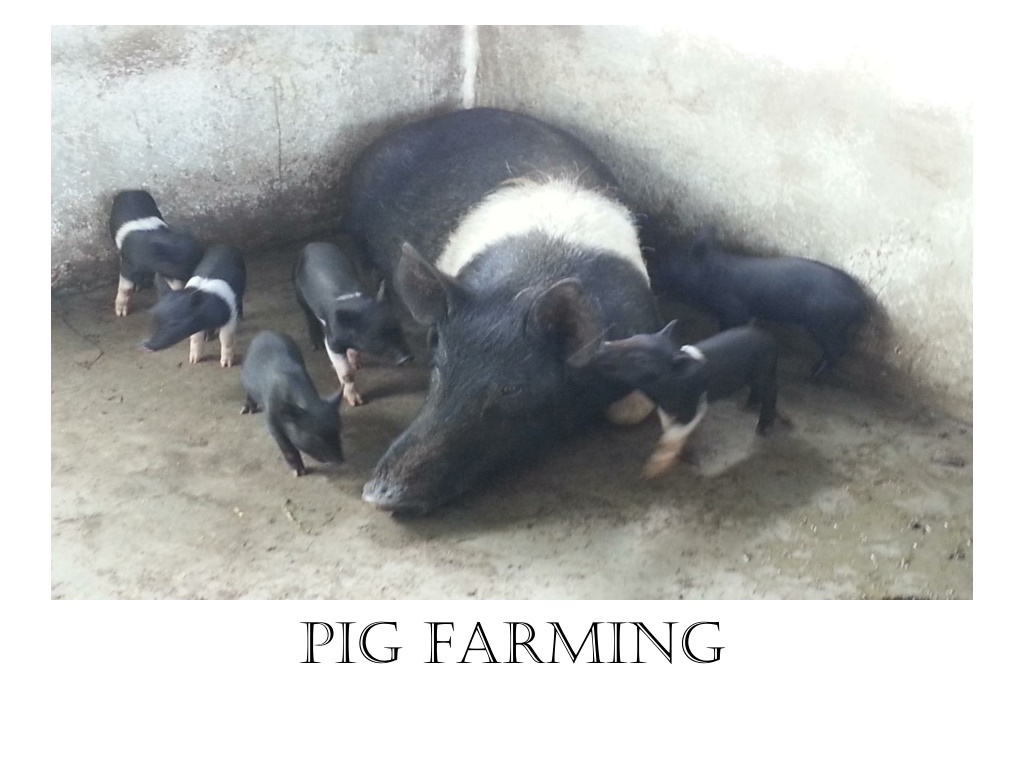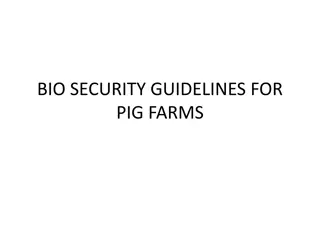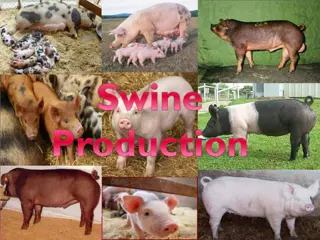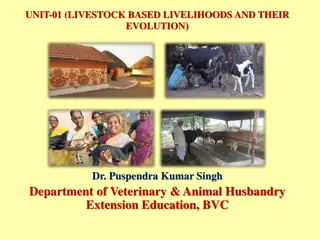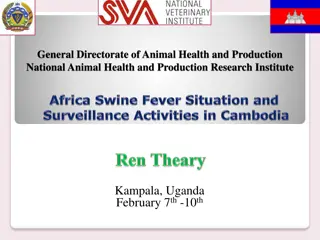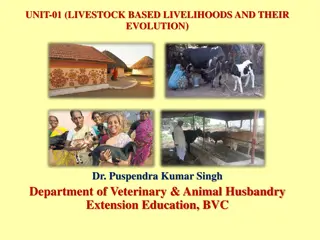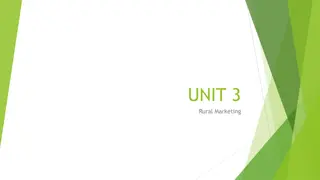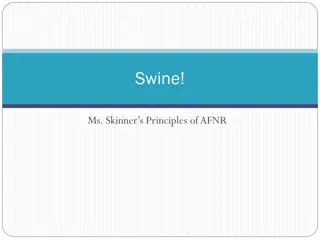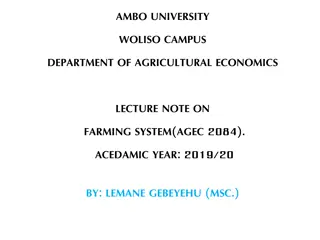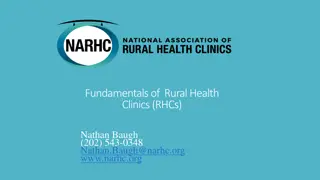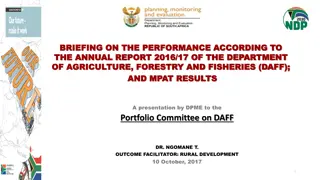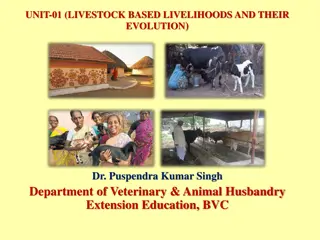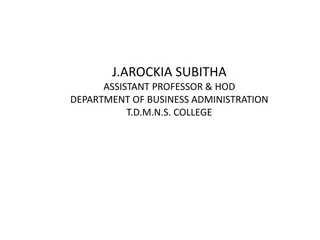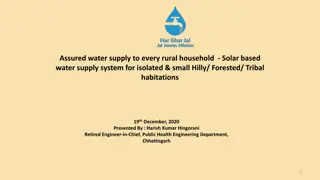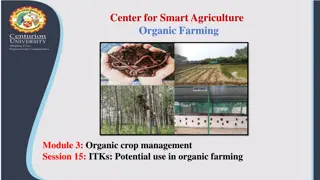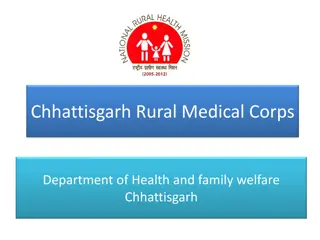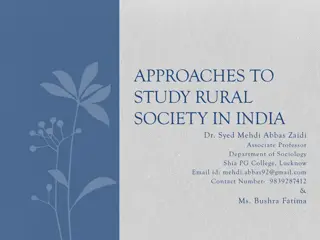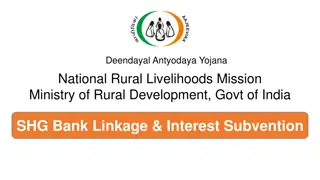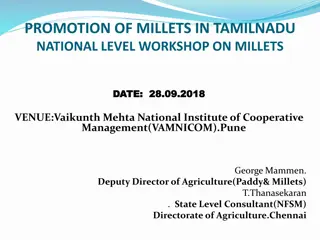Advantages of Pig Farming for Sustainable Livelihood in Rural Areas
Pig farming is a vital sector in rural areas, providing livelihood opportunities and meeting the high demand for pork. This practice offers various advantages such as easy rearing, rapid production, efficient meat production, and satisfactory marketing of grains. Encouraging pig rearing can support improved diets and socio-economic upliftment in districts.
Download Presentation

Please find below an Image/Link to download the presentation.
The content on the website is provided AS IS for your information and personal use only. It may not be sold, licensed, or shared on other websites without obtaining consent from the author. Download presentation by click this link. If you encounter any issues during the download, it is possible that the publisher has removed the file from their server.
E N D
Presentation Transcript
PIG FARMING (A Piggy Bank) Livestock sector has been among the fast growing sectors in rural areas, that is extremely livelihood intensive, self employment and highly remunerative for our farmers.
The people of the North East are generally non- vegetarian due to their tradition, culture and climatic condition and Arunachal is no exception. As such, the demand of piglets and pork is very high but the present availability is inadequate to meet the high demand of local population of this District
In fact, this sector could be very basis of improved diets and is vital in the socio-economy upliftment of the district. Therefore, it is imperative to encourage and promote sustainable and livelihood generating activities such as pig rearing.
Advantage of pig farming 1. Pigs can be reared according to own will in small or large numbers, and decrease the stock. 2. Multiple farrowing: Pig gives many piglets at one farrowing and hence, production can be multiplied rapidly. 3. Pigs grow much faster comparing to other animals. can increase or
4. It is efficient way of producing meat (pork), and with it, protein requirement in human can be meet. Indian Medical Council has advocated that the optimum animal protein requirement is 15g/day/individual, but now, consumed protein is only 6.03g. 5. It is adapted to specialized and diversified type of farming. 6. Pig farming does not require expensive housing and equipments. 7. Labour requirement is less comparing to other livestock enterprises. 8. Quick returns of income.
9. Pigs and breeding stock are readily available. 10. Feed efficiency is higher than any other livestock. 11. Pigs have ability to pick up edible grains. 12. pigs can utilized those grains unfit for human consumption, and therefore, provides satisfactory marketing of those grains
Disadvantage: - Vegetarians and some other person do not take pork.
System of Pig farming 1. Open range system: Animals remain free and not in confinement. Feeding is lesser, labour lowered as animals roaming freely and collecting their feed. However, large space is requiring in this system. 2. Confined system: Animals are kept confined. Growth rate of pig is better and breeding can be done according to own choice in this system, but requires more labour and care as animals are kept confined. 3. Scavenging system: The animals are roaming freely, and use night soil, garbage etc.
Selection of site for farming 1. Pig farm should be in dry and elevated land area. 2. Farm should be well connected with motorable road, but should not be in busy street. 3. Away from human habitation, but nearer to market place where farm product can be easily disposed. 4. Veterinary Dispensary nearby.
5. Farm should be located away from heavy industry to avoid pollution. 6. Farm should have good sources of water supply, electricity provision, and medical facility nearby. 7. Have provision for procuring cheap labour. 8. Farm should have sufficient land area for utilizing farm source, housing, disposal of faeces, storage of feed etc.
Factors to be considered in selection of breed 1. Availability of breeding stock in nearby area. 2. Prolificness: Ability to grow and multiply. 3. Growth ability: some breed grows faster than others. 4. Temperaments: Animal with good temperament should be selected for easy handling. 5. Efficient use of feed: Some animals have high feed efficiency than others. 6. Carcass utility: Animal with high lean meat with low fat content is better.
7. Nicking ability: Breed differs in ability to nourish and large litter of piglets, and able to produce heavier pigs at weaning. 8. Market demand: Breed so selected should have good market demand. In some place, black pigs are demand for pork. 9. Disease resistant: Breed with more disease resistant power be selected. 10. Adaptability: Breed should be such that have ability to perform in different environment. 11. Personnel like and dislike.
Factors to be considered for profitable swine production a. Open range system - i. Use of good breeding stock. ii. Proper management of breeding herd. iii. Proper feeding and management of during gestation period. iv. Proper feeding of sow and litter during and after farrowing. v. Iron injection to be given on 4th & 14th day of birth of piglet to prevent piglet anaemia.
b. Confined system i. Provide adequate legume pasture. ii. Maintain efficient feeding and water equipments. iii. Feed adequate ration. iv. Provide satisfactory housing.
Ration for Pig: Ingredients i. Maize crush rich in carbohydrate, used for energy. ii. GNC rich in protein, brown colour. iii. Wheat bran carbohydrate, more white & rough than rice polish. iv. Fish meal - protein. v. Rice polish carbohydrate. vi. MOC almost brown color. vii. TOC ( Til Oil Cake ) Black color. viii. Bone meal protein.
Composition of ration for swine: Sl.N o 1. 2. 3. 4. 5. 6. Feed Ingredient Starter/creep Grower Finisher Maize G.N.C Wheat bran Fish meal Mineral mixture Salt TOTAL 60% 20% 9% 8% 2.5% 0.5% 100% 50% 20% 22% 5% 2.5% 0.5% 100% 35% 20% 37% 5% 2.5% 0.5% 100%
Types of ration:- i. Starter ration/Creep ration: 1st week of age to weaning or 56 days. The ration is rich in vitamin, minerals, and is supplement of mothers milk. Butter milk, skimmed milk can also be used. ii. Grower ration: Weaning to 35 Kg or 5.5 months of age. iii. Finisher ration: Above 35 Kg or 5.5 months of age.
Ration is to be given twice in a day, once in a morning (9.30am) and once in afternoon(3.30 pm). Pig weighing 70 kg and above may require 2 2.5 kg of ration/ day. Advance pregnant animal & breeding boar during breeding season require energy & protein for maintaining health..
Feeding of pregnant sow: Flushing is to be done in case of pregnant sows. Flushing means giving extra ration containing vitamin, minerals, protein for better health to an animal prior to 2 3 weeks of farrowing and service. This helps mother nourishing piglets inside the uterus. Hence, mother maintaining good health secretes more milk and litter size also becomes bigger. Non conventional feed is actually not advisable to feed, however to maintain income, it is used in finisher feed such as garbage (swill), fruit factory waste, but this should be boil to kill germs.
Breeds of Pig:- A. Old established breed: Sl.No. Name of breed Original place Colour & body marking Ear type 1. Landrace Denmark White Large & drooping Erect Erect Drooping Erect 2. 3. 4. 5. Yorkshire Tamworth Duroc Hampshire England England USA USA White Red Red Black with white belt over the chest & extending to the forelegs White Blact with white on feet & switch Black with white on face, feet, leg & switch. Black with white spot Black with white belt 6. 7. Chesterwhite USA Berkshire Drooping Erect UK 8. Poland china USA Drooping 9. 10. Spot Saddle back USA UK Drooping Erect
Hampshire was established in the year 1893, has excellent motherly ability, and could be used effectively for cross breeding programme
B. New breed: They are cross bred, established from old established breed, giving good production. Beltsville-1 Beltsville-2 USA USA Black with white spot Light red Drooping Erect Minnesota-1 USA Red Slightly erect Minnesota-2 USA Black with white spot Slightly erect Minnesota-3 USA Light red with black spot Black with white spot Slightly erect Maryland USA Erect Montane USA Black Slightly drooping Lacombe USA Black Drooping Sam pierre USA Black & white Erect Palouse USA White Slightly erect to drooping
Identification of animal: Identification of the animal can be done by following method - i. Ear notching ii. Ear tagging iii. Tattooing or by iv. Branding.
Judging of Swine type i. Observation of animal from a distance when it is in group. ii. Close observation of animal to detect the defect. iii. Make the animal walk and observe to find the defect. iv. Pedigree record of the particular animal
v. Other observation includes colour, conformation, body marking, shape and size, nos. of teat etc. - Nos of teat should be 12 14, if the teat is too much rudimentary then the animal may not have milk secretion ability. - Pig should have firm and well arch back and well set ventral line. - Should have strong pastern. - Feet & legs should have no deformities. - Ham should be deep, well set and firm. - Side should be deep, firm and smooth
Routine and periodical job in pig farm These jobs are essential for maintaining the farm. a. Routine job: i. Cleaning and disinfection of sty ii. Feeding and watering (twice daily). iii. Spotting out sick animals iv. Maintenance of proper record.
b. Periodical job:- i. weaning ii. Vaccination iii. Castration iv. Cutting of needle teeth v. ear notching vi. putting the sows into farrowing pen viii. Helping of farrowing sows ix. Transfer of pigs x. Balancing of body weight of animals, that is, litter weight at birth and at weaning.
Working scheduled in pig farm a. Morning i. Cleaning and disinfection early in the morning before feeding. ii. Feeding & watering iii. Spotting out the sick animal. b.Noon = i. weaning ii. Deworming iii. Service iv. weighing v. Needle teeth cutting. c. Evening - I. Cleaning and disinfection including disposal faeces ii. Feeding of ration iii. Record keeping ( Maintenane of record ).
RECORD KEEPING a. Feed record i. Date of issued ii. Quantity issued iii. Cost of feed iv. Sources from which received. b. Labour record i. No. of labour engaged ii. Date iii. Wage per person. c. Farrowing register- i. No. of litter farrowed & Date ii. No. of litter weaned & date iii. Name of sow
d. Breeding register i. Name of pig ii. Date of service iii. Identification marks. e. Health care & mortality record i. Preventive vaccine given to prevent the epidemic form of diseases such as Swine fever, Hog cholera, FMD, Anthrax etc. ii. Deworming done periodically, also need feacal examination, type of medicine used to be recorded. iii. Treatment register date & medicine used to be recorded. iv. Mortality register Date of death & cause of mortality be recorded.
f. Herd or pedigree record - pedigree means record of ancestor up to four times generation. Each animal s history is recorded from birth onward. Nicking ability, growth rate, performance of animal can be known with this record. g. Overall record/ complete enterprise record.
CARE AND MANAGEMENT DURING AND AFTER FARROWING 1. Attendant should look after the sow and piglets. 2.Disinfection of farrowing pen before farrowing. 3. Pregnant sow should be transferred to farrowing pen 3 4 days before expected date of farrowing, that of is 114+3 days after service. 4. Cleaning of tongue, eyes and nostril of piglets. 5. Removal of placenta after expulsion of piglets.
6. After removing the placenta, the piglets should be fed as all teats may not function or piglets may not get the teat directly. 7. Runt should be put in pectoral region where more secretion of milk is there. Piglets have habit of sucking that same particular teat, and hence they do not fight for teat. 8. After complete expulsion of piglets, pessaries like Furea bolus should be inserted inside the vagina or uterus for disinfection. 9. Colostrum feeding: colostrums (first milk) which is rich in vitamin a and antibodies should be fed to every piglets as colotrum provides immunity.
10. Cutting of umbilical cord in first day. Apply tr. Iodine or antiseptic ointment after cutting the cord. 11. Cutting of needle teeth in second or third day with the help of tooth nipper to prevent injuries to the mother s teat. 12. Iron injection ( Imferon ) be given 4th & 14th day to prevent piglet anaemia. 13. Copper sulfate solution or iron sulfate solution could be rub on mother s teat, which is also essential to prevent piglet anaemia.
Weaning Weaning means separation of mother from the piglets,usually done at 56 days (8 weeks) of age of piglets. However, weaning is usually done by weight but not by age. Separation of mother have got certain advantages, such as, piglets do not face new environment, although miss their mother. However, early weaning can be done at 21 days of age to obtain multiple farrowing.
Advantages of early weaning includes i. Reduce piglet mortality by preventing crushing of sow over the piglet. ii. Rebreed can be done in shorter period. iii. Prevent health loss of sow iv. Save space requirement. v. Body weight of piglet is better at mature and vi. Prevent transmission of disease and parasite from mother to piglets.
Disadvantages of early weaning i. Cost of raising piglets is high. ii. Skill labour is required. iii.Milk replacer yolk+Glucose+water+antibiotic) iv. Greater devotion is essential. is require (Egg
Foster mother In case of non-functional teat or inverted nipple in mother (Sow) or the sow died after giving birth, the foster mother is used, usually done in large farm. After rubbing the piglets with certain aromatic substances or with certain sort of antiseptic, are transferred to foster mother so as not to recognize them by smelling.
Cause of Mortality in piglets Up to 80% mortality in piglet is found in pre- weaning period. 1. Trampling - Means death or crushing death. This should be taken care of by the attendant. 2. Piglet scouring cause by Escherichia coli, usually found in faecal contamination and hence, disinfection of farrowing pen is essential. 3. Piglet anaemia Iron injection to be given on 4th & 14th day of piglet. 4. Swine fever vaccination in 6 8 weeks of age.
Management of Boar i. Good ration should be given, particularly, breeding boar. ii. Boar should be given exercise to make animal active and for better circulation, otherwise boar will become fatty and thereby loose l reproductive activities. iii. Male/female ratio: 1:4 iv. Breeding be allowed from 12 months of age, but from 18 months - 4 yrs, fertility is high. v. Similar size boar can be kept together, or may house individually.
Advantages i. Boar odour can be removed and thereby improve quality of pork. Ii. Faster growth rate. iii. Barrow can be housed together easily as they are sterile, and also can be housed with sow without any problem. Iv. Housing requirement can be minimized v. Castrated boar becomes more docile and easier to handle. vi. More deposition of fat in body tissues.
Housing for Pig Build your own farm building . Entrance/Door Entrance Guard rail Water trough Farrrowing pen Feed trough Feeding/central passage G.I. pipe Rail Wall wall Run Pen Door Ground Floor plan (Dry stock) Drain
1. Floor space requirement - Fattening pig: 10-16 sq.ft/pig - Fattening pig in yard: 30-40 sq.ft/pig - Farrowing pig: 60-80 sq.ft/sow & litter - Boar pen: 40-50 sq.ft/pig - Creep area: 15 20 sq.ft. 2. Wall: Height of wall should be 4 -5 from the floor. Bricks and concrete are best material for wall. Height of 3 from floor may be constructed with bricks / concrete, while remaining 1 -2 may be of wood or 2 G.I pipe. 3. Door: wide 2 6 3 .
4. Trough: 12 space is require for each pig. Height: 12 and width:15 . 5. Drain: Floor should be laid to fall toward a drain for rapid drainage. 6. Farrowing pen: Guard rail consisting of G.I pipe of 2 diameter or bamboo pole may be placed along the wall. Rail usually fitted 8-10 from and off the wall and floor.
Service In pig, heat last for 2 3 days and service is done in late heat or second day of heat as is most suitable period. Oestrus cycle is 21 days. Heat symptom restlessness, try to mount over other animal or mounted by others, swelling of vulva, mucous discharge, and allow the hand to place over loin region and not running away.
Synchronization Synchronization means giving of some hormonal injection which makes all the animals to come in oestrous at same time. Advantages i. Availability of foster ii. Reduce labour works iii. Could be mated at same time iv. Marketing is also advantage v. weaning can be done at same time and vi. Loss during pre-weaning is loss.
ARTIFICIAL INSEMINATION A.I means process of collection of semen, processed and deposited into the female genital tract artificially when the female is in heat. Advantages i. Large No. of sows can be inseminated by using single boar and ii. Cost of maintenance is reduced by rearing single boar in place of many.
Testing of Boar for fertility: - 3 methods- i. Microscopic examination Motility of semen can be examined in microscope. Zigzag movement of semen indicates good fertility. ii. Mating with 3 4 market gilts: After 21 days if gilt do not return to heat indicates boar fertility. iii. After 21 days of mating, market gilt is slaughter and count for the embryos; and 10 12 embryos indicates high fertility.
System of breeding:- i. Pure breeding: It can be defined as a member of the breed which posses a common ancestry breed and distinct characteristics; e.g pure breed boar x pure breed sow/gilt. These animals may be either registered or eligible for registration in that breed. The objective of pure breeding is to supply pure breed animal for breeding purpose to other farmer s enterprise.
